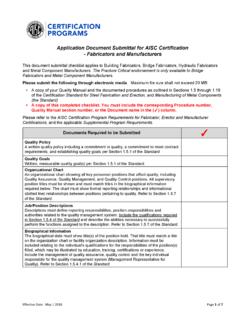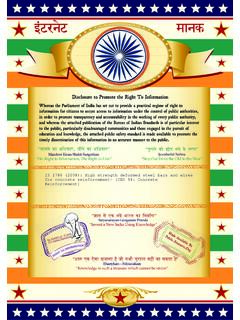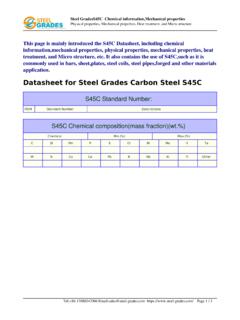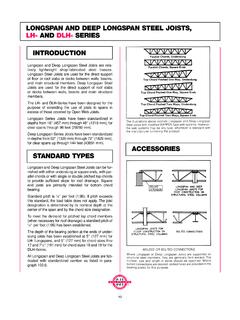Transcription of ARE YOU P SPECIFYING M - AISC
1 By Charles J. Carter, PETHE MATERIALS AND PRODUCTS USEDIN BUILDING DESIGN AND CONSTRUC-TIONare almost universally desig-nated by reference to an appropriateASTM specification. This simplifies thedesign and construction process becauseall characteristics of the product speci-fied are defined by simple reference toan approved standard. However, withdozens of ASTM specifications applica-ble in steel building construction aloneand several new ones now available, itcan be challenging to keep the standarddesignations in contract documents article (Part Two) is a summaryof the common ASTM specificationsused for structural plates, bars andother plate products in building designand construction. Part One (see January 1999 ModernSteel Construction) covered structuralmembers.
2 Part Three will focus on fas-tening generally applicable ASTM speci-fications for structural plates are givenin Table 1. Following is a discussion ofthe usual and other applicable ASTM specifications for structural plates andother plate-type products. The usualASTM specifications are summarized byproduct in Table usual material specification forstructural plates is ASTM A36 (Fy= 36ksi; Fu= 58 ksi). Note that the yieldstrength given is applicable when theplate thickness is equal to or less than8 . Above 8 thickness, Fy= 32 plates with higher yieldand tensile strength can be obtained byspecifying ASTM A572 grade 42, 50, 60or 65, ASTM A529 grade 42 or 50,ASTM A514 grade 90 or 100, or ASTMA852.
3 Structural plates with atmospher-ic corrosion resistance (weathering)characteristics can be obtained by speci-fying ASTM A588 grade 42, 46, or , the availability and cost effec-Modern Steel Construction / February 1999tiveness of structural plates in gradesother than ASTM A36 should be con-firmed prior to their specification. Notealso that the availability of grades otherthan ASTM A36 varies through therange of of the material specifica-tion chosen, the production tolerancesfor structural plates are given in foregoing comments for structur-al plates apply equally to structuralbars, except that neither ASTM A514and nor A852 is applicable. So again,the usual material specification forstructural bars is ASTM A36 (Fy= 36ksi; Fu= 58 ksi).
4 Actually, it should be highlightedthat there is very little, if any, structur-al difference between flat bars andplates. Consequently, plate is becominga universally applied term today and aPL x 4 x 1 -3 , for example, mightbe fabricated from plate or bar AISC s A Guide to Engineeringand Quality Criteria for SteelStructures Common QuestionsAnswered(AISC Publication S323), thehistorical classification system for flatbars and plates would suggest thatthere is only a physical differencebetween them that centers on size (seeTable 3) and production procedure. Inraw form, flat stock has historicallybeen classified as a bar if it is less thanor equal to 8 wide and as a plate if it isgreater than 8 wide.
5 Flat bars arerolled between horizontal and verticalrolls and trimmed to length by shearingor flame cutting on the ends only. Platesare generally produced using one ofthree methods: (1) sheared plates arerolled between horizontal rolls andtrimmed to width and length by shear-ing or flame cutting on the edges andends; (2) universal mill (UM) plates arerolled between horizontal and verticalrolls and trimmed to length by shearingor flame cutting on the ends only; and,(3) stripped plates are sheared or flamecut from wider sheared twoin athree-partseries:structuralplatesModern Steel Construction / February 1999 Table 1. ASTM specifications and their product-specific applicabilityProductApplicable ASTM specificationsNotes:Structural plateA36, A514, A529, A572, A588, A8521 Structural barA36, A529, A572, A5881 Raised-pattern floor plateA7862 Sheet and stripA570, A606, A607 Notes:1.
6 Availability varies through the range of Ordered as "commercial grade" or to plate material specification,such as ASTM A36, A572 or A588. "Commercial grade," per ASTM A786 , means "the product will be supplied percent carbon and without speci-fied mechanical properties." SPECIFYING Plates for Detail MaterialsPlates for detail materials, such as shear plates, flange plates, gusset plates,transverse stiffeners and web doubler plates, are commonly designated with the let-ters PL followed by thickness x width x length. The thickness and width are speci-fied as fractional inch dimensions and the length is specified in feet and , a -thick flange plate with 8 width and 16 length would be specified asPL x 8 x 1 -4 . Similarly, a -thick gusset plate with 18 width and 36 lengthwould be specified as PL x 18 x 3 -0.
7 While structural plates and bars can be produced in thickness increments farsmaller, it is recommended that thicknesses be selected for detail materials in 1/8-inincrements. That is, use thickness increments such as 3/8 and rather than 5/16 and 7/16 , respectively. Fabricators will rarely stock plates in 1/16 thickness 2. Plate products and their usual ASTM specificationsMin. FyMin. FuProductUsual ASTM Specification(ksi)(ksi)Structural plateA363658 Structural barA363658 Raised-pattern floor plateA786see Note 2see Note 2 Other plate productsvaries with applicationvariesvariesNotes:1. Fy= 32 ksi for ASTM A36 material over 8 ordered as "commercial grade", no minimum strength is applicable. If ordered to aplate material specification such as ASTM A36, A572 or A588, Fy and Fuare as specifiedtherein.
8 "Commercial grade," per ASTM A786 Section , means "the product willbe supplied percent carbon and without specified mechanical properties."Modern Steel Construction / February 1999 Table 3. Classification of Plate Products Width (in.)over 31/2over 6over 8over 12over 48 Thickness (in.)to 31/2to 6to 8to 12to and to to to to to sheet and strip not generallyproduced in these widths and thicknessesCharles J. Carter, , is Director ofManuals with the American Institute ofSteel Construction, Inc. and an occasion-al contributor of articles in Modern A786 is the standard specifica-tion for rolled steel floor plates. As floor-plate design is seldom controlled bystrength considerations, ASTM A786 commercial grade is commonly speci-fied. If so, per ASTM A786 Section , the product will be supplied per-cent maximum carbon and withoutspecified mechanical properties.
9 Alternatively, if a defined strength levelis desired, ASTM A786 raised-patternfloor plate can be ordered to a definedplate specification, such as ASTM A36,A572, or A588; see ASTM A786 and 8 and Appendix Table and strip products, which aregenerally thinner than structural plateand bar products (see Table 3), are pro-duced to such ASTM specifications asA570, A606 or A607. Skelp is a generalterm for the plate products used in theproduction of hollow structural sections(HSS).














